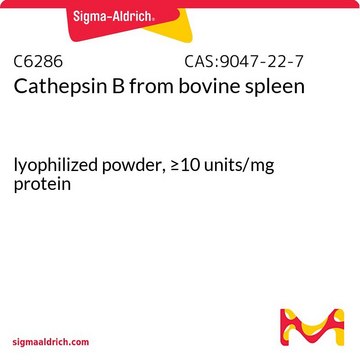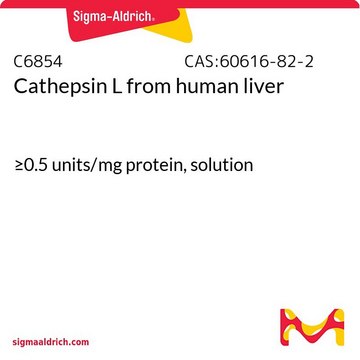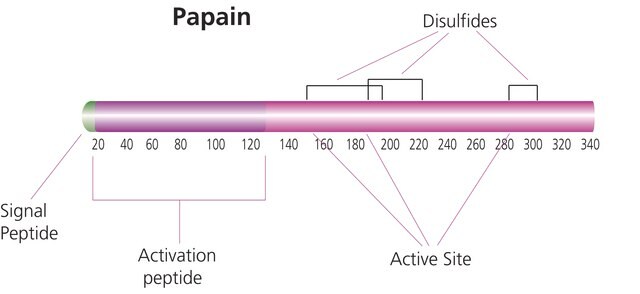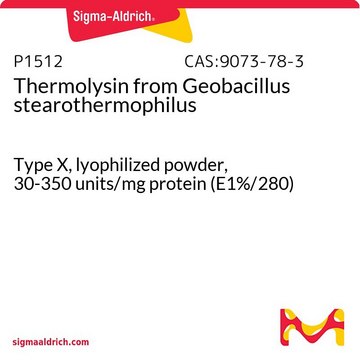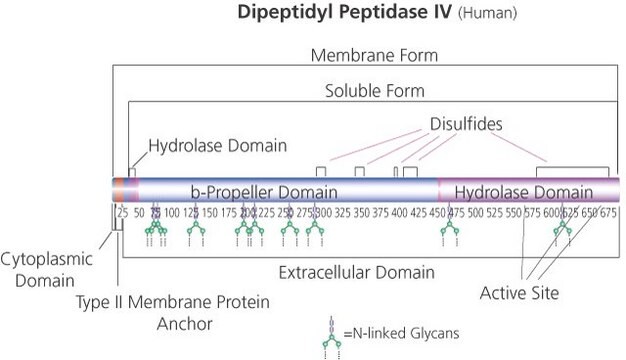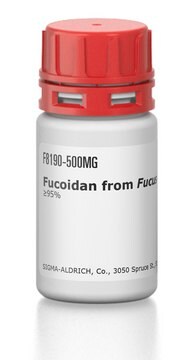C8511
Cathepsin C from bovine spleen
Type X, lyophilized powder, ≥5 units/mg protein
Synonym(s):
Dipeptidyl aminopeptidase, Dipeptidyl peptidase I
Sign Into View Organizational & Contract Pricing
All Photos(1)
About This Item
Recommended Products
biological source
bovine spleen
Quality Level
type
Type X
Assay
>25% protein (biuret)
form
lyophilized powder
specific activity
≥5 units/mg protein
composition
Protein, ≥25% biuret
manufacturer/tradename
Sigma-Aldrich
storage condition
OK to freeze (Unstable. Keep frozen)
concentration
≥5 unit/mg protein
technique(s)
activity assay: suitable
suitability
suitable for molecular biology
application(s)
life science and biopharma
shipped in
dry ice
storage temp.
−20°C
Gene Information
cow ... CTSC(352958)
Related Categories
General description
Research Area: Cell Signaling
Dipeptidyl peptidase I (DPPI), also known as cathepsin C, is an abundant lysosomal cysteine protease from the papain superfamily with a molecular weight of approximately 200 kDa. It is widely expressed in a variety of mammalian tissues, with the highest levels found in the lungs, kidneys, liver, and spleen, and relatively lower levels in the brain.
DPPI is the only member of its family that is functional as a tetramer, consisting of four identical subunits, each composed of an N-terminal fragment, a heavy chain, and a light chain. It is identified as one of the multifaceted protease-processing machines, having been shown to function beyond its role as a non-specific lysosomal protease.
Dipeptidyl peptidase I (DPPI), also known as cathepsin C, is an abundant lysosomal cysteine protease from the papain superfamily with a molecular weight of approximately 200 kDa. It is widely expressed in a variety of mammalian tissues, with the highest levels found in the lungs, kidneys, liver, and spleen, and relatively lower levels in the brain.
DPPI is the only member of its family that is functional as a tetramer, consisting of four identical subunits, each composed of an N-terminal fragment, a heavy chain, and a light chain. It is identified as one of the multifaceted protease-processing machines, having been shown to function beyond its role as a non-specific lysosomal protease.
Application
Cathepsin C from bovine spleen has been used for the in vitro enzyme activity assays. It has also been used as a digestion enzyme for in vitro myelin oligodendrocyte glycoprotein (MOG) digestion.
Cathepsin C has been used in a study that demonstrated the potential of a proteomics approach to identify novel proteins expressed by extravillous trophoblast and to uncover the mechanisms leading to disease states in pregnancy. Cathepsin C has also been used in a study to evaluate biodegradable thermogels.
The enzyme from Sigma has been used in the activation of granzyme k (Gzmk) precursor from E. coli. Granzymes are granule-stored lymphocyte serine proteases that are implicated in T- and natural killer cell-mediated cytotoxic defense reactions.
Biochem/physiol Actions
Cathepsin C (Cat C) serves as the physiological activator of groups of serine proteases within immune and inflammatory cells, playing a crucial role in the defense mechanisms of an organism. It may play a role in chronic airway diseases such as asthma. Cat C also acts as a protease link between inflammation and thrombosis.
Cat C participates in neutrophil recruitment and production of chemokines and cytokines in many inflammatory diseases. Cathepsin C plays a crucial role as an essential enzyme in activating granule serine proteases in cytotoxic T lymphocytes, natural killer cells (granzymes A and B), mast cells (chymase and tryptase), and neutrophils (cathepsin G, proteinase 3, and elastase).
Cat C participates in neutrophil recruitment and production of chemokines and cytokines in many inflammatory diseases. Cathepsin C plays a crucial role as an essential enzyme in activating granule serine proteases in cytotoxic T lymphocytes, natural killer cells (granzymes A and B), mast cells (chymase and tryptase), and neutrophils (cathepsin G, proteinase 3, and elastase).
Cathespin C is a dipeptidyl aminopeptidase that can sequentially remove dipeptides from a peptide chain with an unsubstituted N-terminus. The enzyme exhibits a preference for glycine and proline as N-terminal aminoacids. Substrates that have an N-terminal lysyl or arginyl residue, or a penultimate proryl residue are not targeted by this enzyme. The endopeptidase activity requires the presence of halide ions and sulfydryl activators.
Caution
Unstable. Keep frozen.
Unit Definition
One unit will produce 1 μmole of Gly-Phe-NHOH from Gly-Phe-NH2 and hydroxylamine per min at pH 6.8 at 37 °C using DL-phenylalanine hydroxamic acid as the standard. In addition to its hydrolytic properties, cathepsin C catalyzes the polymerization of dipeptide amides.
Physical form
Lyophilized from a 1 M sodium chloride solution.
substrate
Product No.
Description
Pricing
Storage Class Code
11 - Combustible Solids
WGK
WGK 3
Flash Point(F)
Not applicable
Flash Point(C)
Not applicable
Personal Protective Equipment
dust mask type N95 (US), Eyeshields, Gloves
Choose from one of the most recent versions:
Already Own This Product?
Find documentation for the products that you have recently purchased in the Document Library.
Customers Also Viewed
The specificity of dipeptidyl transferase.
I M Voynick et al.
Biochemistry, 7(1), 40-44 (1968-01-01)
H Lindley
The Biochemical journal, 126(3), 683-685 (1972-02-01)
1. The characterization of cathepsin C as an aminodipeptidase has been confirmed. 2. An extra limitation on its specificity, namely that peptides involving proline as the third residue are immune to the enzyme, has been found. 3. A novel technique
High immunoglobulin E in a Chinese Papillon-Lefèvre syndrome patient with novel compound mutations of cathepsin C.
Xuan Wen et al.
The Journal of dermatology, 39(7), 664-665 (2012-01-10)
Case of rippled-pattern sebaceoma with clinically yellowish surface and histopathological paucity of lipid-containing neoplastic cells.
Yoshio Kawakami et al.
The Journal of dermatology, 39(7), 644-646 (2011-11-15)
Mayumi Ueta et al.
Japanese journal of ophthalmology, 55(4), 405-410 (2011-05-28)
We previously reported that human conjunctival epithelial cells expressed functioning interleukin-4 receptor α (IL-4Rα). In this study, we investigated whether human corneal epithelial cells also express functioning IL-4Rα. The presence of IL-4Rα mRNA and protein in human corneal epithelium was
Our team of scientists has experience in all areas of research including Life Science, Material Science, Chemical Synthesis, Chromatography, Analytical and many others.
Contact Technical Service